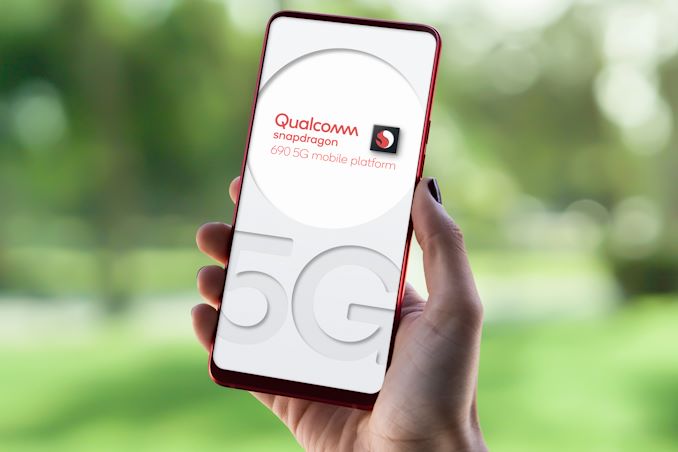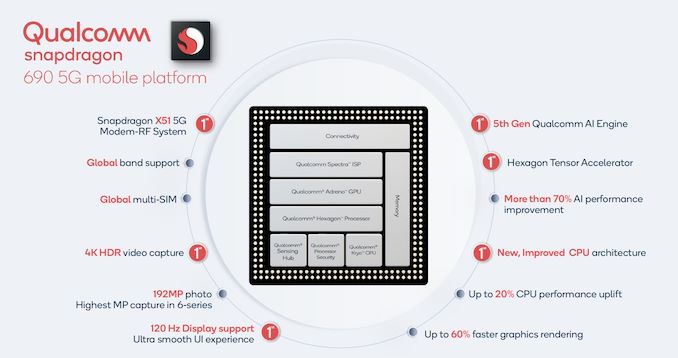Qualcomm Announces Snapdragon 690: 5G & A77 In The Mid-Range
by Andrei Frumusanu on June 16, 2020 10:00 PM EST- Posted in
- Mobile
- Qualcomm
- Smartphones
- SoCs
- Snapdragon 690

Today Qualcomm is extending its 5G SoC portfolio down to the Snapdragon 600-series, introducing the new Snapdragon 690 platform and chip. The new design is a more significant upgrade to the 600-series, not only upgrading the cellular capabilities, but also upgrading some of the cornerstone IPs to the newest generation available.
| Qualcomm Snapdragon 600-Range SoCs | |||||||
| SoC | Snapdragon 660 | Snapdragon 662 | Snapdragon 665 | Snapdragon 670 | Snapdragon 675 | Snapdragon 690 | |
| CPU | 4x Kryo 260 (CA73) @ 2.2GHz 4x Kryo 260 (CA53) @ 1.8GHz |
4x Kryo 260 (CA73) @ 2.0GHz 4x Kryo 260 (CA53) @ 1.8GHz |
4x Kryo 260 (CA73) @ 2.0GHz 4x Kryo 260 (CA53) @ 1.8GHz |
2x Kryo 360 (CA75) @ 2.0GHz 6x Kryo 360 (CA55) @ 1.7GHz |
2x Kryo 460 (CA76) @ 2.0GHz 6x Kryo 460 (CA55) @ 1.7GHz |
2x Kryo 560 (CA77) @ 2.0GHz 6x Kryo 560 (CA55) @ 1.7GHz |
|
| GPU | Adreno 512 | Adreno 610 | Adreno 615 | Adreno 612 | Adreno 619L | ||
| DSP | Hexagon 680 | Hexagon 683 | Hexagon 686 | Hexagon 686 | Hexagon 685 | Hexagon 692 |
|
| ISP/ Camera |
Spectra 160 24MP |
Spectra 340T 25MP single / 16MP dual |
Spectra 165 25MP single / 16MP dual |
Spectra 250 25MP single / 16MP dual |
Spectra 250 25MP single / 16MP dual |
Spectra 355L 48MP single / 32+16MP dual |
|
| Memory | 2x 16-bit @ 1866MHz LPDDR4 14.9GB/s |
2x 16-bit @ 1866MHz LPDDR4X 14.9GB/s 1MB system cache |
|||||
| Integrated Modem | Snapdragon X12 LTE | Snapdragon X11 LTE (Cat 12/13) DL = 390Mbps 2x20MHz CA, 256-QAM UL = 150Mbps 2x20MHz CA, 64-QAM |
Snapdragon X12 LTE (Category 12/13) DL = 600Mbps 3x20MHz CA, 256-QAM UL = 150Mbps 2x20MHz CA, 64-QAM |
Snapdragon X51 ( LTE ) DL = 1200 Mbps UL = 210 Mbps ( 5G NR Sub-6 ) DL = 2500 Mbps UL = 1200 Mbps |
|||
| Encode/ Decode |
2160p30, 1080p120 H.264 & H.265 |
1080p60 H.264 & H.265 |
2160p30, 1080p120 H.264 & H.265 |
||||
| Mfc. Process | 14nm LPP | 11nm LPP | 11nm LPP | 10nm LPP | 11nm LPP | 8nm LPP | |
Although the new Snapdragon 690 maintains its CPU configurations in terms of big and little cores in a 2+6 setup, Qualcomm has managed to include the newest Cortex-A77 IP for the big CPU cores, resulting in a 20% performance uplift thanks to the microarchitectural improvements. The clock speeds remain the same as found in other recent 600-series designs, meaning 2GHz on the big cores and 1.7GHz for the A55 cores.
On the GPU side, we see the shift to a new Adreno 619L design sees a much bigger shift with an up to 60% increase in performance compared to the previous generation Snapdragon 675.
Memory-wise, it’s still a LPDDR4X SoC with dual 16-bit channel support, which is plenty for the bandwidth requirements at this performance segment.
Qualcomm is also trickling down some of the newer higher end multimedia features to the 600-series, such as the newer generation Spectra iSP which is able to support up to 192MP still pictures or up to 48MP sensors with multi-frame noise reduction, or a dual-camera setup in tandem of 32+16MP sensors. The chip has a 10-bit capture and display pipeline, allowing it 4K HDR capture and display – although we didn’t see mention of 4K60 recording.
The key feature of the Snapdragon 690 is its shift towards a 5G modem platform. The integrated X51 modem now adds support for 5G sub-6GHz with global band support. The speeds here scale up to 2500Mbps downstream and 1200Mbps upstream on sub-6 networks, utilising up to 100MHz of spectrum bandwidth. The chip seemingly makes without mmWave connectivity, and this makes a lot of sense given the price range that the 600-series is meant to be used in, as well as the general lack of mmWave adoption in most markets.
“This new platform is designed to make 5G user experiences even more broadly available around the world. Snapdragon 690 also supports remarkable on-device AI and vibrant entertainment experiences. HMD Global, LG Electronics, Motorola, SHARP, TCL, and Wingtech are among the OEMs/ODMs expected to announce smartphones powered by Snapdragon 690.”
We’re expecting the new chip to be deployed in devices by various vendors in the second half of the year.











24 Comments
View All Comments
leexgx - Thursday, June 18, 2020 - link
surprised no one has complained about the super short range MMwave yet (even though it's not important compared to having full sub 6ghz to 700 mhz support witch your phone will see for the majority of the time)Great_Scott - Thursday, June 18, 2020 - link
That makes sense - Qualcomm can know(guess) that MMwave is DOA for pretty much everyone.Other than sub-6 5G support I don't really see much difference between the 670, 675, and 690.
Fortunately the 5G rollout is so slow and painful that good 4G phones should be good to use for the foreseeable future.
The good news here is limited since the SOCs with no A-7x at all are still hanging around on new phones giving people slow and buggy experiences on 8-12 cores.
leexgx - Saturday, June 20, 2020 - link
main benefit of the 690 5g is the 4G will be faster (has faster LTE modem and more LTE bands support) and have support for even faster 5g for later on if you get a signalwell at some point providers are going to be moving 4G into split share with 5G so Dynamic Spectrum Sharing (DSS) so it can use 5g and 4g at same time
so unlike 3g to 4g where you could only be on 3g or 4g (with 3g voice fall back when it worked, the random missed call texts when your phone didn't ring but it hit voicemail and they hang up)
with x51 it can do both 4g and 5g combined (X51 and higher) and you get data speed from both 4g and 5g technologies (where provider support is enabled for it)
all in one x51 or higher modems with required 5g antennas (not X50 it has 5g but has a separate 5g modem that is not part of the 2g/3g/4g modem that is inside the SOC) so avoid any phone with 855+ SOC (even there website does not put 5g next to it just a + all other SOCs with a dedicated 2g to 5g modem or built into the SOC has 5g on it)
the 7-8 series have support for MMwave (lots of phones only have Sub 6ghz hardware which really is not a problem a MMwave is super short range to be network financially profitable)
we might get it in the UK but its use be very limited use (i would of said large sport/events and transport stations but with currant covid situation 20Ghz+ deployment would be very little use, maybe 5 years)
0iron - Friday, June 19, 2020 - link
So, 6 series will run out of name!